Abstract
Succinylacetone (4,6-dioxoheptanoic acid) is an abnormal metabolite produced in patients with hereditary tyrosinemia as a consequence of an inherited deficiency of fumarylacetoacetate hydrolase. It is known that patients with this hereditary disease excrete excessive amounts of δ-aminolevulinic acid (ALA) in urine and that certain patients have an accompanying clinical syndrome resembling that of acute intermittent porphyria (AIP). In order to elucidate the relation of succinylacetone to the heme biosynthetic pathway, we have examined the effects of this metabolite on the cellular heme content of cultured avian hepatocytes and on the activity of purified ALA dehydratase from normal human erythrocytes and from mouse and bovine liver. Our data indicate that succinylacetone is an extremely potent competitive inhibitor of ALA dehydratase in human as well as in animal tissues. By using purified preparations of the enzyme from human erythrocytes and mouse and bovine liver, an inhibitor constant ranging from 2 × 10-7 M to 3 × 10-7 M was obtained. In cultured hepatocytes, succinylacetone also inhibited ALA dehydratase activity, decreased the cellular content of heme and cytochrome P-450, and greatly potentiated the induction response of ALA synthase to drugs such as phenobarbital, chemicals such as allylisopropylacetamide and 3,5-dicarbethoxy-1,4-dihydrocollidine, and natural steroids such as etiocholanolone. Four patients with hereditary tyrosinemia have been studied and all were found to have greatly depressed levels of erythrocyte ALA dehydratase activity and elevated concentrations of this inhibitor in urine. These findings indicate that tyrosinemia is a disorder of special pharmacogenetic interest because succinylacetone, an abnormal product of the tyrosine metabolic pathway, resulting from the primary gene defect of the disease, profoundly inhibits heme biosynthesis in normal cells through a blockade at the ALA dehydratase level, leading to clinical and metabolic consequences that mimic another genetic disease, AIP.
Full text
PDF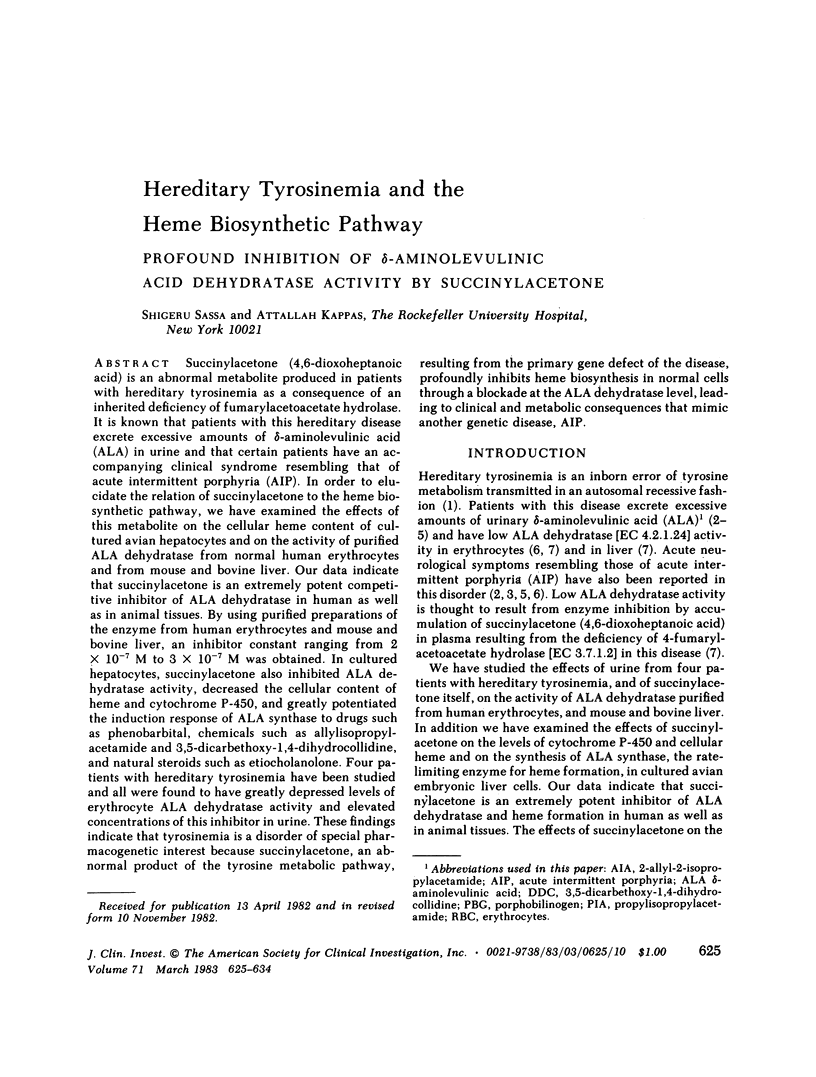
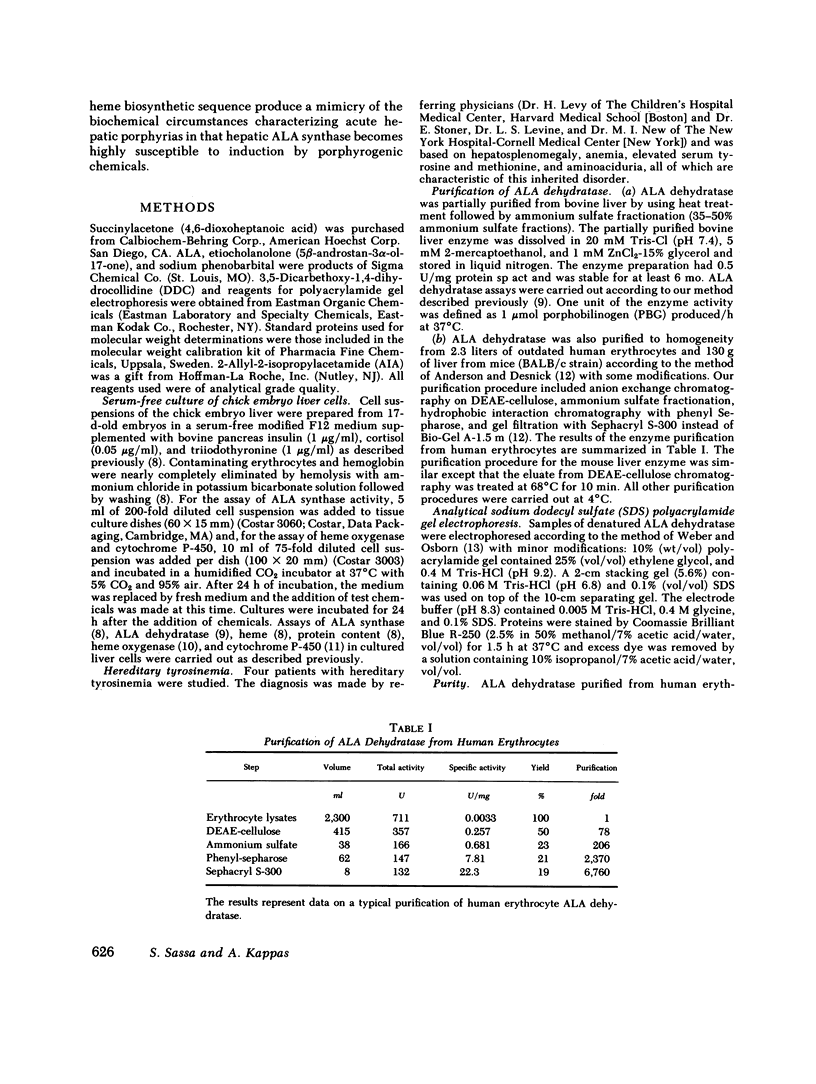
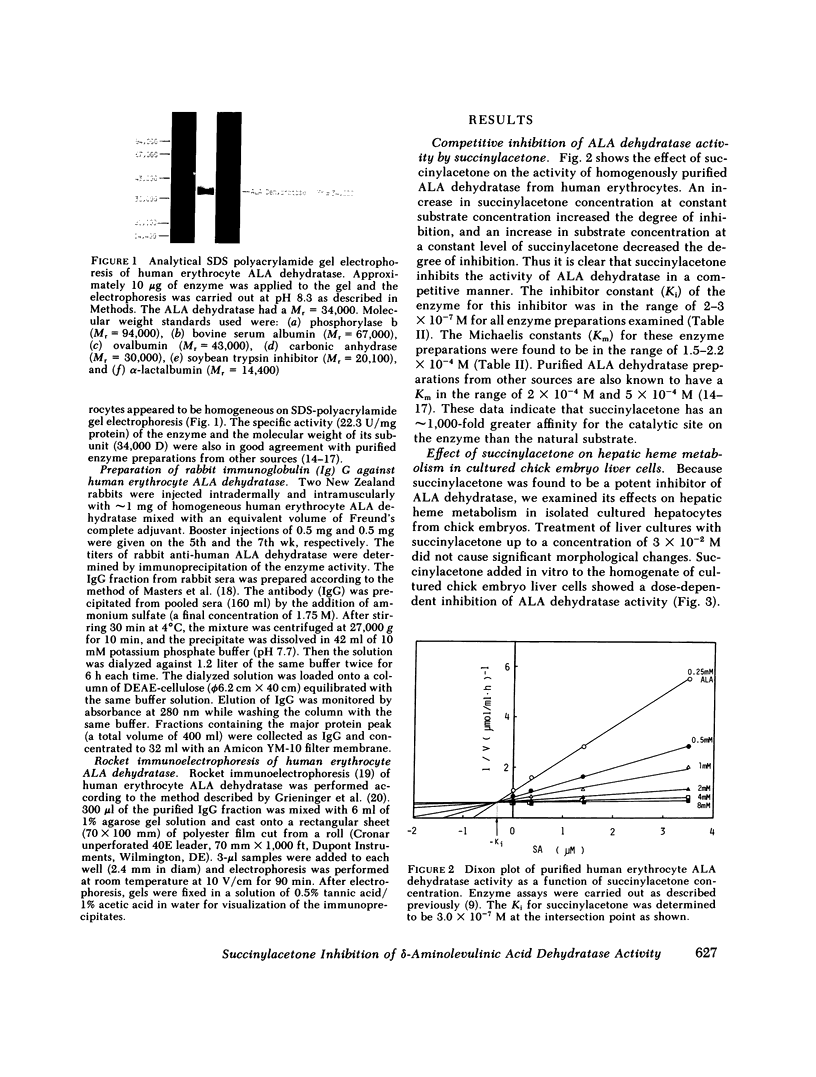
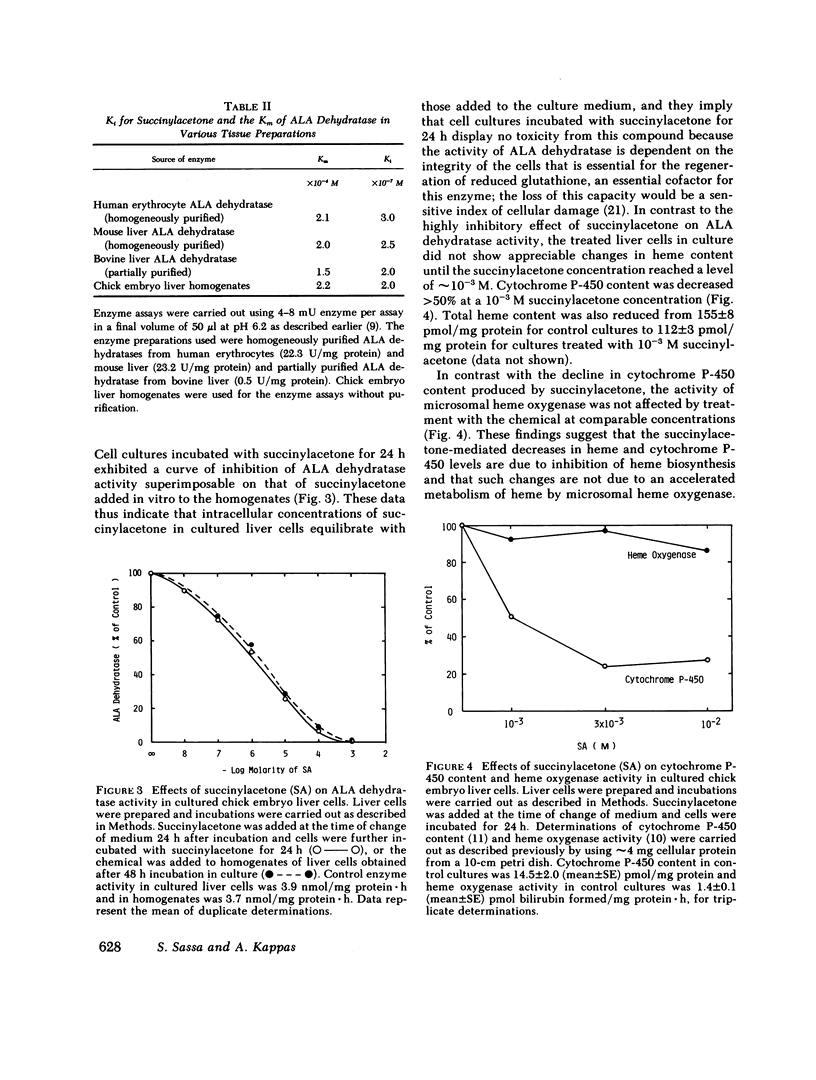
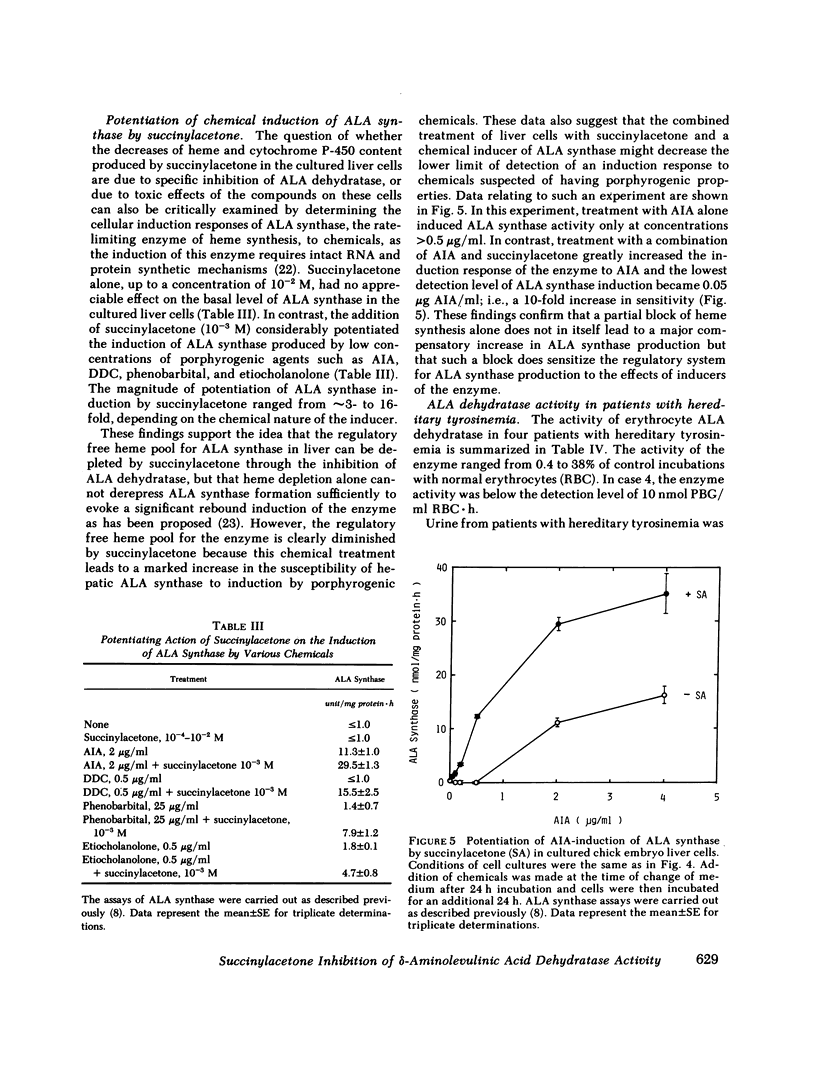

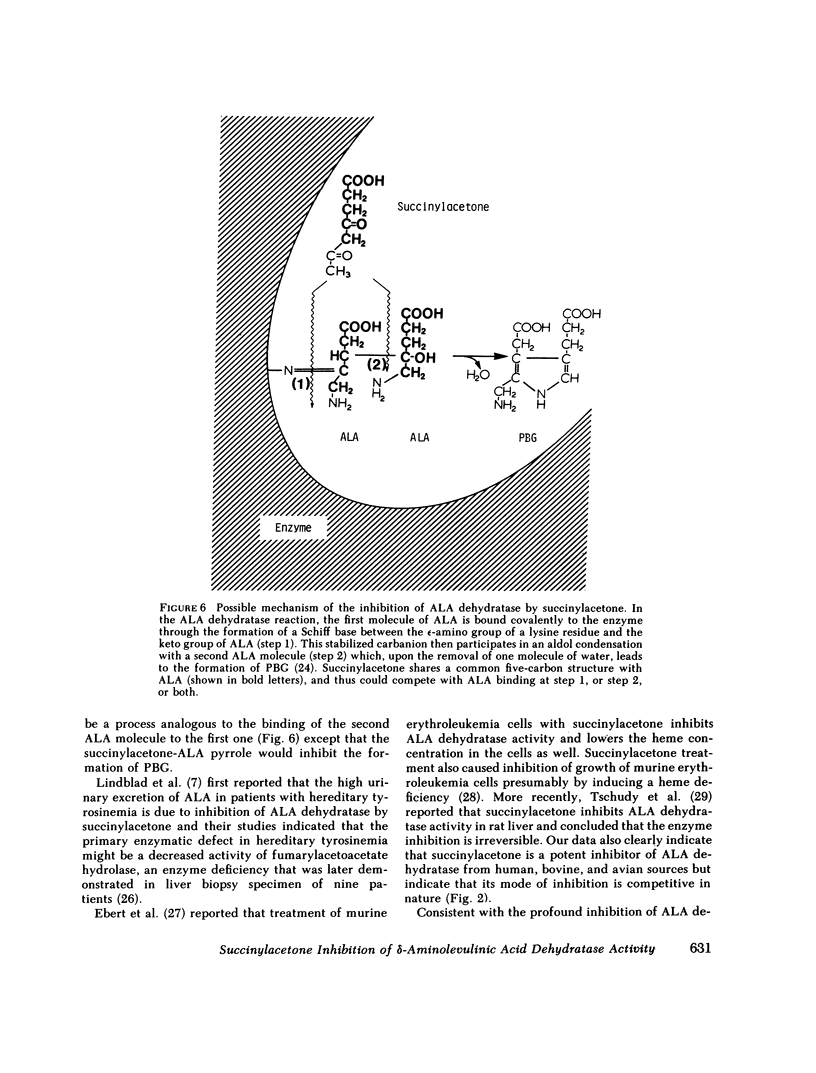
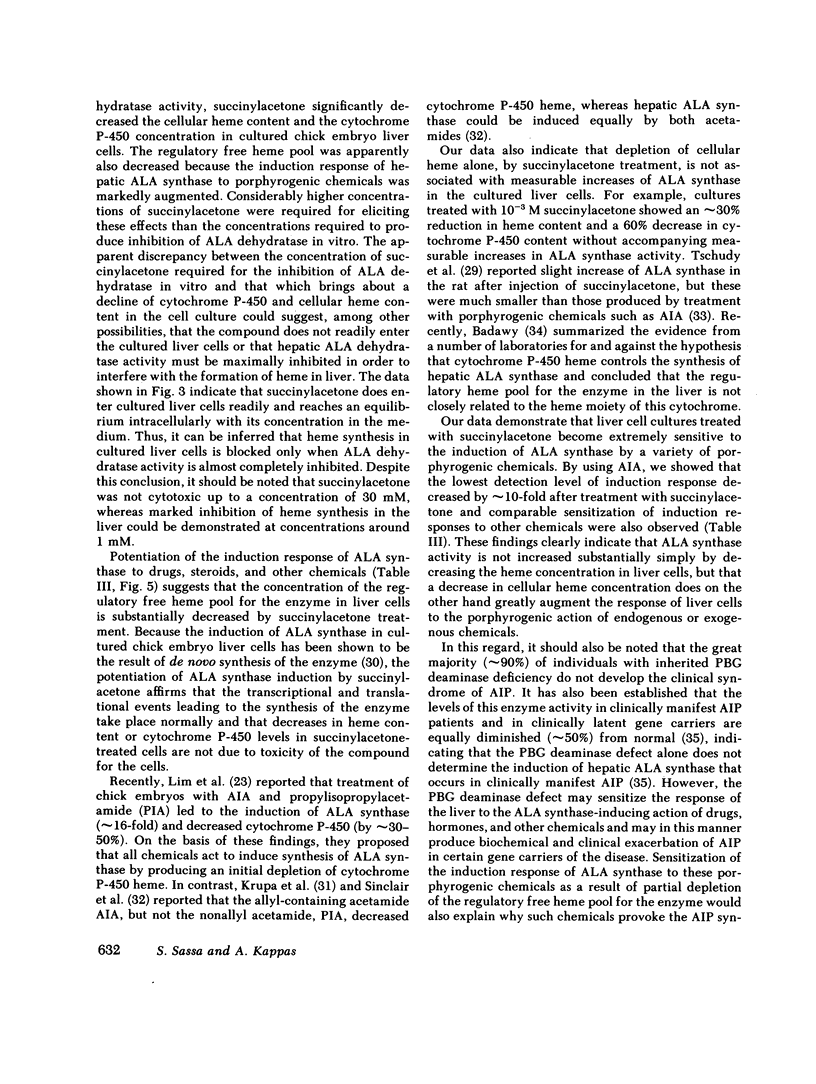

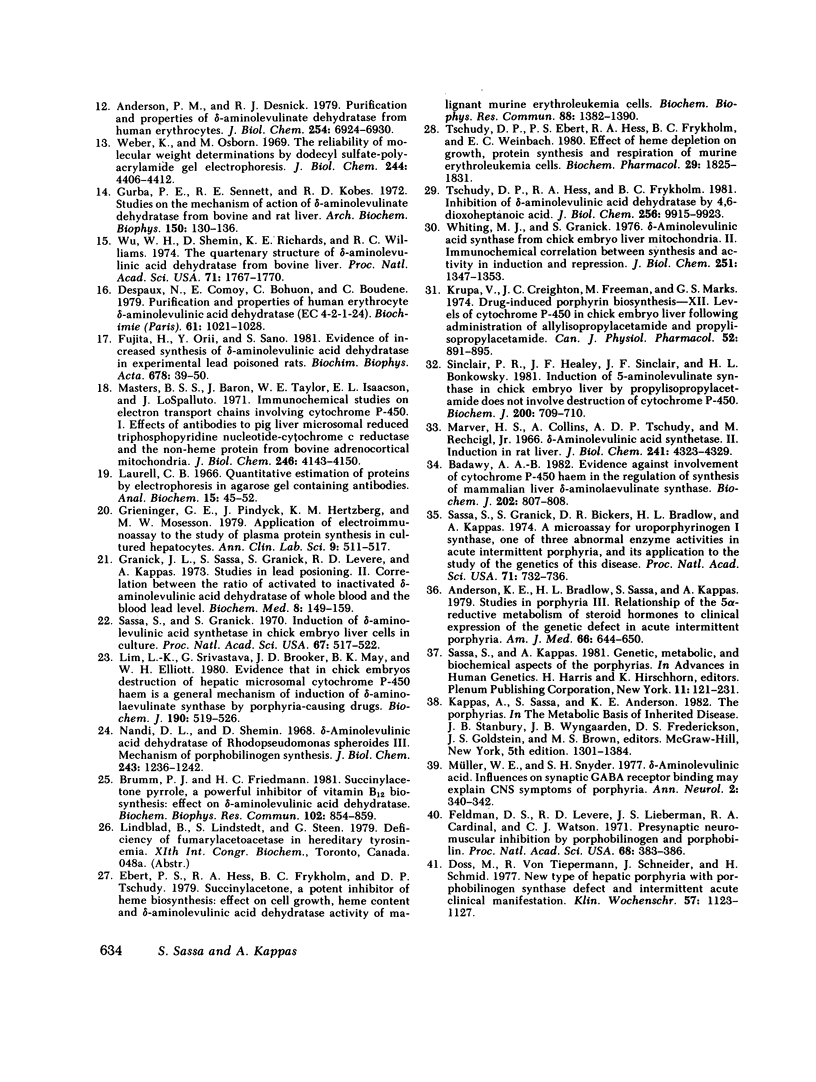
Images in this article
Selected References
These references are in PubMed. This may not be the complete list of references from this article.
- Anderson K. E., Bradlow H. L., Sassa S., Kappas A. Studies in porphyria. VIII. Relationship of the 5 alpha-reductive metabolism of steroid hormones to clinical expression of the genetic defect in acute intermittent porphyria. Am J Med. 1979 Apr;66(4):644–650. doi: 10.1016/0002-9343(79)91176-8. [DOI] [PubMed] [Google Scholar]
- Anderson P. M., Desnick R. J. Purification and properties of delta-aminolevulinate dehydrase from human erythrocytes. J Biol Chem. 1979 Aug 10;254(15):6924–6930. [PubMed] [Google Scholar]
- Badawy A. A. Evidence against involvement of cytochrome P-450 haem in the regulation of synthesis of mammalian liver 5-aminolaevulinate synthase. Biochem J. 1982 Mar 15;202(3):807–808. doi: 10.1042/bj2020807. [DOI] [PMC free article] [PubMed] [Google Scholar]
- Brumm P. J., Friedmann H. C. Succinylacetone pyrrole, a powerful inhibitor of vitamin B12 biosynthesis: effect of delta-aminolevulinic acid dehydratase. Biochem Biophys Res Commun. 1981 Oct 15;102(3):854–859. doi: 10.1016/0006-291x(81)91616-8. [DOI] [PubMed] [Google Scholar]
- Delta-Aminolevulinic acid synthase from chick embryo liver mitochondria. II. Immunochemical correlation between synthesis and activity in induction and repression. J Biol Chem. 1976 Mar 10;251(5):1347–1353. [PubMed] [Google Scholar]
- Despaux N., Comoy E., Bohuon C., Boudène C. Purification and properties of human erythrocyte delta-amino-levulinic acid dehydratase (EC 4-2-1-24). Biochimie. 1979;61(9):1021–1028. doi: 10.1016/s0300-9084(80)80256-2. [DOI] [PubMed] [Google Scholar]
- Doss M., von Tiepermann R., Schneider J., Schmid H. New type of hepatic porphyria with porphobilinogen synthase defect and intermittent acute clinical manifestation. Klin Wochenschr. 1979 Oct 15;57(20):1123–1127. doi: 10.1007/BF01481493. [DOI] [PubMed] [Google Scholar]
- Ebert P. S., Hess R. A., Frykholm B. C., Tschudy D. P. Succinylacetone, a potent inhibitor of heme biosynthesis: effect on cell growth, heme content and delta-aminolevulinic acid dehydratase activity of malignant murine erythroleukemia cells. Biochem Biophys Res Commun. 1979 Jun 27;88(4):1382–1390. doi: 10.1016/0006-291x(79)91133-1. [DOI] [PubMed] [Google Scholar]
- Feldman D. S., Levere R. D., Lieberman J. S., Cardinal R. A., Watson C. J. Presynaptic neuromuscular inhibition by porphobilinogen and porphobilin. Proc Natl Acad Sci U S A. 1971 Feb;68(2):383–386. doi: 10.1073/pnas.68.2.383. [DOI] [PMC free article] [PubMed] [Google Scholar]
- Fujita H., Orii Y., Sano S. Evidence of increased synthesis of delta-aminolevulinic acid dehydratase in experimental lead-poisoned rats. Biochim Biophys Acta. 1981 Nov 18;678(1):39–50. doi: 10.1016/0304-4165(81)90045-3. [DOI] [PubMed] [Google Scholar]
- Gaull G. E., Rassin D. K., Solomon G. E., Harris R. C., Sturman J. A. Biochemical observations on so-called hereditary tyrosinemia. Pediatr Res. 1970 Jul;4(4):337–344. doi: 10.1203/00006450-197007000-00004. [DOI] [PubMed] [Google Scholar]
- Gentz J., Johansson S., Lindblad B., Lindstedt S., Zetterström R. Exertion of delta-aminolevulinic acid in hereditary tyrosinemia. Clin Chim Acta. 1969 Feb;23(2):257–263. doi: 10.1016/0009-8981(69)90040-0. [DOI] [PubMed] [Google Scholar]
- Gentz J., Lindblad B., Lindstedt S., Levy L., Shasteen W., Zetterstrom R. Dietary treatment in tyrosinemia (tyrosinosis). With a note on the possible recognition of the carrier state. Am J Dis Child. 1967 Jan;113(1):31–37. doi: 10.1001/archpedi.1967.02090160081006. [DOI] [PubMed] [Google Scholar]
- Granick J. L., Sassa S., Granick S., Levere R. D., Kappas A. Studies in lead poisoning. II. Correlation between the ratio of activated to inactivated delta-aminolevulinic acid dehydratase of whole blood and the blood lead level. Biochem Med. 1973 Aug;8(1):149–159. doi: 10.1016/0006-2944(73)90018-5. [DOI] [PubMed] [Google Scholar]
- Grieninger G., Pindyck J., Hertzberg K. M., Mosesson M. W. Application of electroimmunoassay to the study of plasma protein synthesis in cultured hepatocytes. Ann Clin Lab Sci. 1979 Nov-Dec;9(6):511–517. [PubMed] [Google Scholar]
- Gurba P. E., Sennett R. E., Kobes R. D. Studies on the mechanism of action of -aminolevulinate dehydratase from bovine and rat liver. Arch Biochem Biophys. 1972 May;150(1):130–136. doi: 10.1016/0003-9861(72)90019-7. [DOI] [PubMed] [Google Scholar]
- Kang E. S., Gerald P. S. Hereditary tyrosinemia and abnormal pyrrole metabolism. J Pediatr. 1970 Sep;77(3):397–406. doi: 10.1016/s0022-3476(70)80006-3. [DOI] [PubMed] [Google Scholar]
- Krupa V., Creighton J. C., Freeman M., Marks G. S. Drug-induced porphyrin biosynthesis--XII. Levels of cytochrome P-450 in chick embryo liver following administration of allylisopropylacetamide and propylisopropylacetamide. Can J Physiol Pharmacol. 1974 Aug;52(4):891–895. doi: 10.1139/y74-114. [DOI] [PubMed] [Google Scholar]
- Laurell C. B. Quantitative estimation of proteins by electrophoresis in agarose gel containing antibodies. Anal Biochem. 1966 Apr;15(1):45–52. doi: 10.1016/0003-2697(66)90246-6. [DOI] [PubMed] [Google Scholar]
- Lim L. K., Srivastava G., Brooker J. D., May B. K., Elliott W. H. Evidence that in chick embryos destruction of hepatic microsomal cytochrome P-450 haem is a general mechanism of induction of delta-aminolaevulinate synthase by porphyria-causing drugs. Biochem J. 1980 Sep 15;190(3):519–526. doi: 10.1042/bj1900519. [DOI] [PMC free article] [PubMed] [Google Scholar]
- Lindblad B., Lindstedt S., Steen G. On the enzymic defects in hereditary tyrosinemia. Proc Natl Acad Sci U S A. 1977 Oct;74(10):4641–4645. doi: 10.1073/pnas.74.10.4641. [DOI] [PMC free article] [PubMed] [Google Scholar]
- Maines M. D., Kappas A. Cobalt stimulation of heme degradation in the liver. Dissociation of microsomal oxidation of heme from cytochrome P-450. J Biol Chem. 1975 Jun 10;250(11):4171–4177. [PubMed] [Google Scholar]
- Marver H. S., Collins A., Tschudy D. P., Rechcigl M., Jr Delta-aminolevulinic acid synthetase. II. Induction in rat liver. J Biol Chem. 1966 Oct 10;241(19):4323–4329. [PubMed] [Google Scholar]
- Masters B. S., Baron J., Taylor W. E., Isaacson E. L., LoSpalluto J. Immunochemical studies on electron transport chains involving cytochrome P-450. I. Effects of antibodies to pig liver microsomal reduced triphosphopyridine nucleotide-cytochrome c reductase and the non-heme iron protein from bovine adrenocortical mitochondria. J Biol Chem. 1971 Jul 10;246(13):4143–4150. [PubMed] [Google Scholar]
- Müller W. E., Snyder S. H. delta-Aminolevulinic acid: influences on synaptic GABA receptor binding may explain CNS symptoms of porphyria. Ann Neurol. 1977 Oct;2(4):340–342. doi: 10.1002/ana.410020415. [DOI] [PubMed] [Google Scholar]
- Nandi D. L., Shemin D. Delta-aminolevulinic acid dehydratase of Rhodopseudomonas spheroides. 3. Mechanism of porphobilinogen synthesis. J Biol Chem. 1968 Mar 25;243(6):1236–1242. [PubMed] [Google Scholar]
- Sassa S., Granick S., Bickers D. R., Bradlow H. L., Kappas A. A microassay for uroporphyrinogen I synthase, one of three abnormal enzyme activities in acute intermittent porphyria, and its application to the study of the genetics of this disease. Proc Natl Acad Sci U S A. 1974 Mar;71(3):732–736. doi: 10.1073/pnas.71.3.732. [DOI] [PMC free article] [PubMed] [Google Scholar]
- Sassa S., Granick S. Induction of -aminolevulinic acid synthetase in chick embryo liver cells in cluture. Proc Natl Acad Sci U S A. 1970 Oct;67(2):517–522. doi: 10.1073/pnas.67.2.517. [DOI] [PMC free article] [PubMed] [Google Scholar]
- Sassa S., Kappas A. Genetic, metabolic, and biochemical aspects of the porphyrias. Adv Hum Genet. 1981;11:121–231. doi: 10.1007/978-1-4615-8303-5_3. [DOI] [PubMed] [Google Scholar]
- Sassa S., Kappas A. Induction of aminolevulinate synthase and porphyrins in cultured liver cells maintained in chemically defined medium. Permissive effects of hormones on induction process. J Biol Chem. 1977 Apr 10;252(7):2428–2436. [PubMed] [Google Scholar]
- Sinclair J. F., Sinclair P. R., Bonkowsky H. L. Hormonal requirements for the induction of cytochrome P-450 in hepatocytes cultured in a serum-free medium. Biochem Biophys Res Commun. 1979 Feb 14;86(3):710–717. doi: 10.1016/0006-291x(79)91771-6. [DOI] [PubMed] [Google Scholar]
- Sinclair P. R., Healey J. F., Sinclair J. F., Bonkowsky H. L. Induction of 5-aminolaevulinate synthase in chick embryo liver by propylisopropylacetamide does not involve destruction of cytochrome P-450. Biochem J. 1981 Dec 15;200(3):709–710. doi: 10.1042/bj2000709. [DOI] [PMC free article] [PubMed] [Google Scholar]
- Strife C. F., Zuroweste E. L., Emmett E. A., Finelli V. N., Petering H. G., Berry H. K. Tyrosinemia with acute intermittent porphyria: aminolevulinic acid dehydratase deficiency related to elevated urinary aminolevulinic acid levels. J Pediatr. 1977 Mar;90(3):400–404. doi: 10.1016/s0022-3476(77)80701-4. [DOI] [PubMed] [Google Scholar]
- Tschudy D. P., Ebert P. S., Hess R. A., Frykholm B. C., Weinbach E. C. Effect of heme depletion on growth, protein synthesis and respiration of murine erythroleukemia cells. Biochem Pharmacol. 1980 Jun 15;29(12):1825–1831. doi: 10.1016/0006-2952(80)90145-8. [DOI] [PubMed] [Google Scholar]
- Tschudy D. P., Hess R. A., Frykholm B. C. Inhibition of delta-aminolevulinic acid dehydrase by 4,6-dioxoheptanoic acid. J Biol Chem. 1981 Oct 10;256(19):9915–9923. [PubMed] [Google Scholar]
- Weber K., Osborn M. The reliability of molecular weight determinations by dodecyl sulfate-polyacrylamide gel electrophoresis. J Biol Chem. 1969 Aug 25;244(16):4406–4412. [PubMed] [Google Scholar]
- Wu W. H., Shemin D., Richards K. E., Williams R. C. The quaternary structure of delta-aminolevulinic acid dehydratase from bovine liver. Proc Natl Acad Sci U S A. 1974 May;71(5):1767–1770. doi: 10.1073/pnas.71.5.1767. [DOI] [PMC free article] [PubMed] [Google Scholar]



